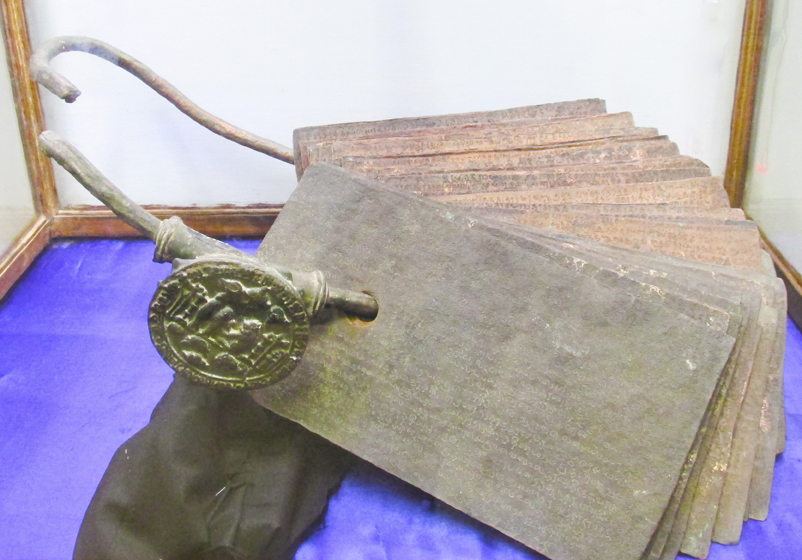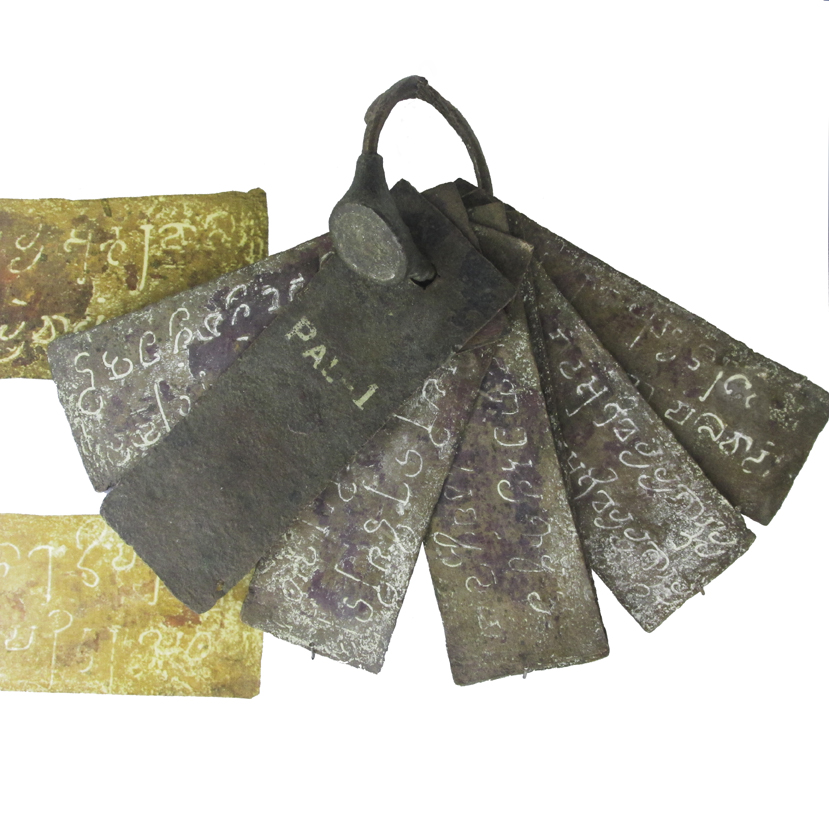
Chola copper plate inscriptions (11th Century AD) with the
Chola Seal
Inscriptionsetched on stone seen on the walls and pillars of temples are well-known. Similar epigraphs etched on sheets of copper are not that well known. The newly refurbished section of copper plate inscriptions inside the Stone Sculpture Gallery of the Madras Museum in Egmore has on display many of these rare inscriptions issued by important dynasties of South India. These are part of a 600-plus collection. Written in different scripts and many languages, these epigraphs range in date from the 3rd Century CE to recent times.
What exactly is the content of these copper plate inscriptions? They usually mention grants of villages or plots of cultivable lands to private individuals or public institutions by kings. Names of monarchs, their achievements, officials, queens, princes, places, dates and much, much more can be gleaned from these priceless etchings on copper which are a mine of information for historians and archaeologists. Many of them even have the name of the poet who composed the verses and also the name of the engraver. They were given to the donees as documentary proof of the donation. Luckily, most of these inscriptions have been edited and translated by scholars and their contents made known to the academic world. These copper plates, usually rectangular in shape, have round holes near the margin to allow a circular copper ring to pass through to which is attached the seal of the dynasty which issued the inscription.

Pallava copper-plate inscription.
The earliest copper plate on display, dated approximately to the 4th Century CE, belongs to the Pallava dynasty. As in the case of many of these copper plate epigraphs, this was discovered quite by accident in 1899 while a field was being ploughed near Maidavolu village in Guntur District, Andhra Pradesh. The language of this donative epigraph is Prakrit and the script is the southern Brahmi. The bull emblem of the Pallavas adorns the elliptical seal on the copper ring of these plates.
It is the Chola copper plate grants that take one’s breath away. All of them are bi-lingual, the first part composed in Sanskrit and etched in the Grantha script and the second portion in Tamil. One of the best-known in the fields of history and archaeology is the large Thiruvalangadu copper plate inscription discovered in Thiruvalangadu near Arakonam. It consists of 31 large plates strung on a ring to which is attached a seal showing the Chola emblem of the tiger and many other symbols alongside proclaiming the greatness of the Imperial House of the Cholas, totally weighing 92 kg.
Even bigger than the Thiruvalangadu plates is the huge and heavy Karandai copper plate charter (1019 CE) unearthed in a field in Puttur village, Thanjavur District. It consists of 57 plates and a massive ring with the Chola seal, weighing in all approximately 111 kg. Both the Thiruvalangadu and Karandai copper plates date to the reign of the illustrious Rajendra Chola I who ascended the Chola throne in 1014 CE – exactly one thousand years ago today.
Occupying centrestage in the gallery is the enormous Thiruvindalur copper plate grant, the biggest, heaviest and lengthiest in India thus far discovered. Any onlooker would marvel at its sheer size and bulk! Dated 1058 CE, it is of the time of Rajendra Chola II. This inscription, comprising 85 rectangular copper plates, each plate uniformly 44 cm in length and 21 cm in breadth, was discovered accidentally in May 2010 at a depth of twelve feet in a trench along with many ancient bronze images when the Kailasanatha temple in Thiruvindalur village (near Mayiladuthurai) was being renovated. Needless to say, the plates too are bound by a copper ring with Chola seal, which are intact after nearly 1000 years. The weight is an unbelievable 150 kg.
Copper plates of the Chera dynasty (11th-12th century CE), Krishnadeva Raya of Vijayanagara (16th century CE), Pandyas (16th century CE), Nayak rulers of Madurai (17th century CE), Setupati Raja of Ramnad (17th century CE) and even one of the British period of the 19th century can be seen here. The last mentioned records a settlement made by a committee of three members, namely Andrew Scott, Collector of Guntur, John Read, Collector of Masulipatnam, and I.L. Caldwell, Superintendent of Tank Repairs, regarding distribution of water from some channels of the River Kistna (Krishna) to the villages of Bapatla and Chukur (Cherukuru). The copper plates are secured by a ring, the ends of which, interestingly, have a figure of Ganesha!
Such an array of ancient copper plate inscriptions is rare to see. I wonder how many in Chennai even know about this gallery?
|

